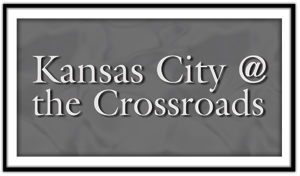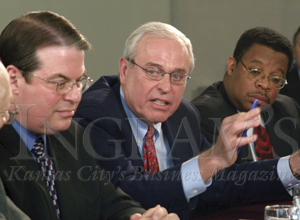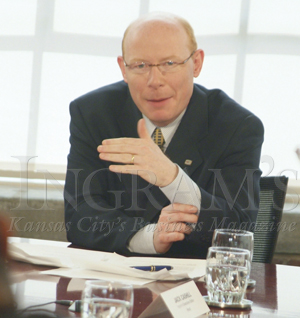
There’s Still Hope for the
Bi-State Concept
What have we learned?
KCPT’s Haines asked Rep. Nolte what lessons had been learned from Bi-state II. Nolte said that besides the complexity of the ballot issue, that all three major areas-Kansas, Jackson County, and the Northland-must be represented and have their needs met. When Haines asked him if Bi-state II helped people in his constituency-north of the river-Nolte said, “If there was a gain to be had, it wasn’t communicated.
Jack Cashill, Ingram’s Executive Editor, said that he supported Bi-state I because it addressed a specific need. “With Bi-state II, the mission was forgotten and the tax was preserved.”
“Was Bi-state II a tax searching for a problem?” Haines asked.
Craft said no, noting that when the Truman Sports Com-plex was built in the early 1970s Jackson County occupied about 70 percent of the economic base in metropolitan Kansas City. That is no longer the case. He further stated that a new plan has to be implemented to solve the issue that is sustaining major league sports in Kansas City. “There is no question that an overwhelming majority of the public of greater Kansas City believes that their lives would not be as pleasant if the two teams (Royals and Chiefs) were no longer a part of Kansas City,” he said.
Flaherty vehemently disagreed, at least with the premise that it was up to the public to sustain the teams. “You say the Royals want to be competitive? The Yankees’ starting rotation earns more money than the entire Royals’ roster,” he said. “There’s no way we’ll ever be competitive. It’s a deception to tell the people that if you vote for this we can make the Royals competitive.”
Craft defended his position by saying the goal was to sustain the teams, not make them competitive. But Haines responded with a question for Craft. How can the $80 million raised over four years by the August sales tax vote in Jackson County do it, when before it “re-quired” half a billion with Bi-state II?
Craft said that the sales tax deals with the improvements required in the lease, not the improvements that would sustain the teams for the near future. The arts’ Byrne jumped back in on the question of whether Bi-state II was a tax in search of a problem.
Unequivocally no,” he stated. “Kansas City has among the lowest public funding for the arts and culture of any city in the United States. Among the top 50 cities in America, KC’s public funding is around number 46 or 47. Among symphony orchestras alone, if we received the average that symphonies around the nation do from state and local funding sources, our orchestra would receive $1.3 million a year, not the $60,000 that we got last year.”
But Rep. Schwab would not let Byrne off the hook. “Nobody knows you’re on a $60,000 budget, but we know the payroll and the salary cap issues as they relate to the Chiefs,” he said. “There isn’t the synergy yet. I would like to see a Bi-state specifically for the arts to show this community there’s not the interest there; we need to gen-erate that before we fund it. There has to be a groundswell of desire.”
“The polling has shown that an arts-only Bi-state campaign would pass,” Byrne countered.
“But the polls also showed that [this last Bi-state] was close, and it wasn’t,” Schwab replied.
Senator O’Connor agreed with Schwab. “There are plenty of people who think that the arts should be supported privately. This isn’t an argument against you,” she said, directing her remarks at Byrne and the arts community, “it’s just a matter of the facts of life. You’re going to have to deal with it. There is a whole, huge entity out there that says, arts should not be supported with tax dollars.”
Jack Cashill responded, “If a combination of markets and phil-anthropies can’t support an insti-tution, maybe it’s time to let the institution go.”
Not giving up, Byrne said, “Why then, in cities around the nation, to which we aspire to be, is there significant public funding that underwrites excellence in the arts?”

Where do we go from here?
Sensing maybe that continuing would only exacerbate things, Haines decided to take the discussion in a different tack. “So what would it take for the next Bi-state to seduce voters on both sides of the state line to support it?”
Almost unanimously, it was agreed that the right topic could revive the concept. And there was near unanimity on what that topic might be.
City Manager Cauthen was first to jump in. “It may take the issue of transportation,” he said. “That’s something we all have to deal with. We all realize that I-35 is getting a lot more bogged down with traffic. We also know that if we don’t do something now, in the future, it’s going to cost more to pay for those things.”
Rep. Nolte believes his north-of-the-river constituents would support it, if it were framed properly. “The people have to want it,” he said. He also noted that it had to be perceived as a need, not just a want. “In the state legislature, we’ve made some difficult decisions about cuts. It’s hard to be a proponent of a cultural tax and yet have to preside over some very painful cuts in other areas.”
The talk about transportation raised the interest of Mark Huffer of the KCATA. “I think we have to look at what we want to become as a region,” he said. He noted that the Kansas City region is one of the very few in the country in which the only dedicated source for public transit comes from the largest urbanized area.
“Everywhere else in the country, transit is supported on at least a county-wide basis, and in many cases a multiple-county or regional funding mechanism,” Huffer added. “We think transit is becoming a hot issue. Gasoline is $2.14 and if you listen to analysts, they’re talking about $3/gallon gasoline in the next year.
“Our region is a product of decisions that were made decades ago,” Huffer continued. We’ve decentralized many of our assets; they’re spread out over a large area and we’ve connected them with interstate. It’s going to make providing transit to those sources difficult, but it’s something that needs to be done.”
The Northland is not the only region that might support a Bi-state on mass transit. Rep. Schwab believes that Johnson Countians would support it, and so does Sen. O’Connor.
“I think there’s more synergy for that, especially when they go to other cities and the first thing they see is a transit system,” Schwab said.
Flaherty was quick to point out that citizens will not go for it- even if it is needed-unless their tax carries a voice. “We are digging our heels in,” he said. “We are either going to be an equal partner or there is not going to be a partnership.”
KCATA’s Huffer said that it’s difficult to look at transportation in a jurisdictional manner, because by its very nature, it crosses jurisdictions. To say that a busline from Independence to Olathe doesn’t benefit another part of the metro is short-sighted. “We have to look at transportation as something that needs to go throughout the region,” Huffer said.
But the money required for an extensive mass transit system is expected to be far larger than the money requested in Bi-state II. Herb Kohn, who supported both Bi-states, thinks that the Kansas Speedway in Village West and the new Sprint Center downtown may hold the key to a successful venture. “I think we need to keep in mind the possibility of creating some sort of public/private partnership.” Kohn also believes that there should be a regional governance that comprises representation from all areas in the metro, even establishing such a group permanently, “instead of trying to create one on an ad hoc basis.”
Sen. O’Connor then stopped the group with her possible support of a mass-transit Bi-state. “Mass transit is a problem that needs to be dealt with,” she said. “I see no reason why you can’t have a proposal that deals with where we’re going to start.” She added that the other areas of need could be dealt with as they arise.
That announcement amused Nick Haines, who said, in regardsto Senator O’Connor’s potential support, “People, I believe we have made history here today.”
Huffer noted that the KCATA Board is a bi-state board with five representatives from Kansasand five from Missouri, representing a total of seven area counties. He believes the mechanism is in place to get the ball rolling.

Bi-state III?
Nick Haines then asked the final question: “What would it take to match the mission and vision that would get the voters on board another Bi-state tax.
Sen. O’Connor and Jack Cashill agreed that there was nothing that could do that, at least at the present time. Most of the others felt that with the right topic-and Cauthen still pushed that it was transportation-another Bi-state would have a chance. All agreed that any effort would have to include equal representation from both sides of the state line. Rep. Nolte and Kohn agreed that we must learn from past failures. And Byrne could not resist one final chance to push the arts.
“What we need is vision,” he said. “What this community aspires to be, in terms of a great city in the Mid-western United States, includes a major component for arts and culture that is currently seriously un-der-funded through public sources. What we need is leadership and vision that will speak to the kind of city we want to be, not the kind of city that we are.”
When Haines asked him if that’s not what Bi-state II tried to do, Byrne said, “The second package did not paint the clearest picture to appeal to the voters. It’s not that what we were trying to accomplish was flawed, it is the mechanism was not as clear and as compelling as we would have liked.”